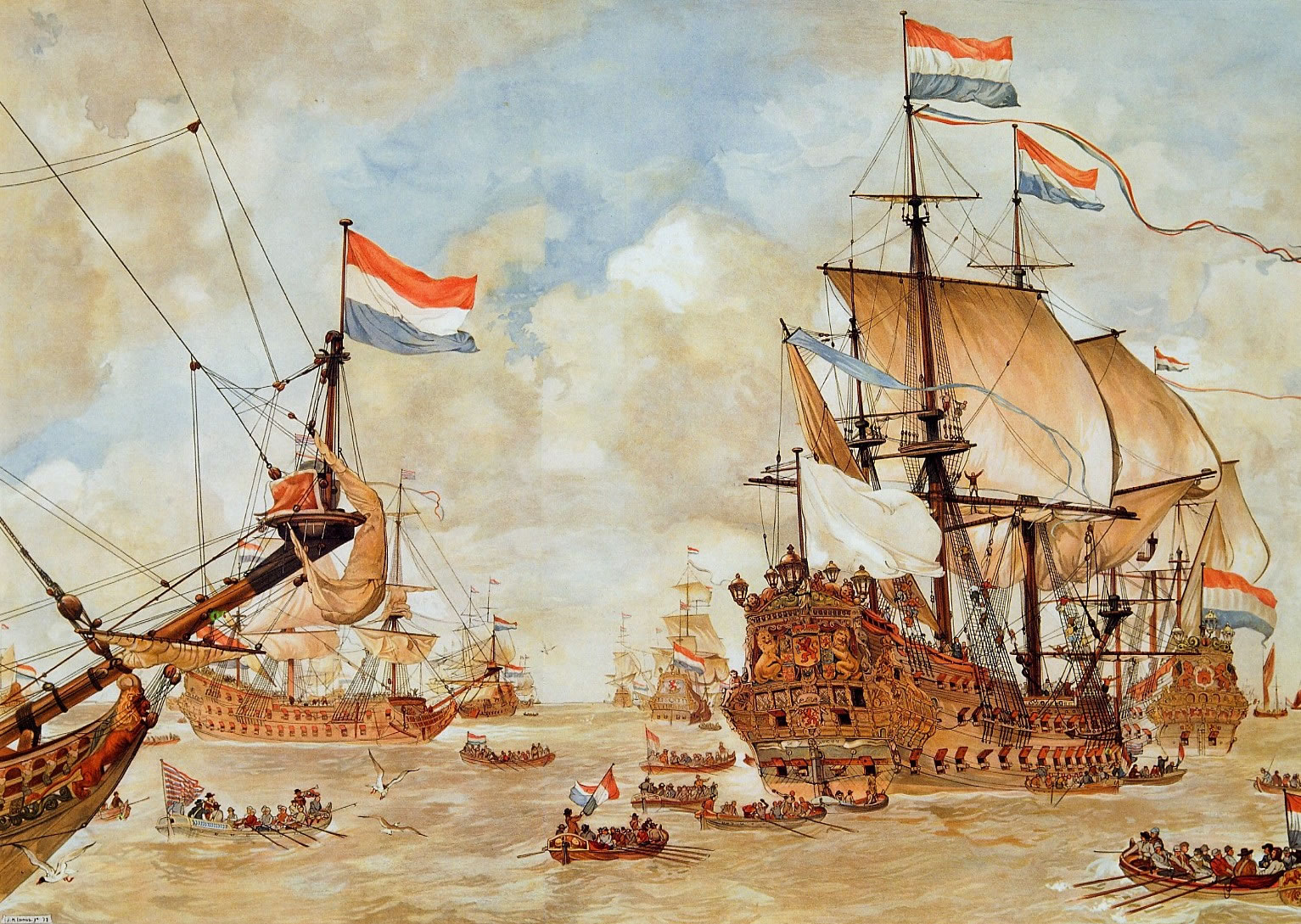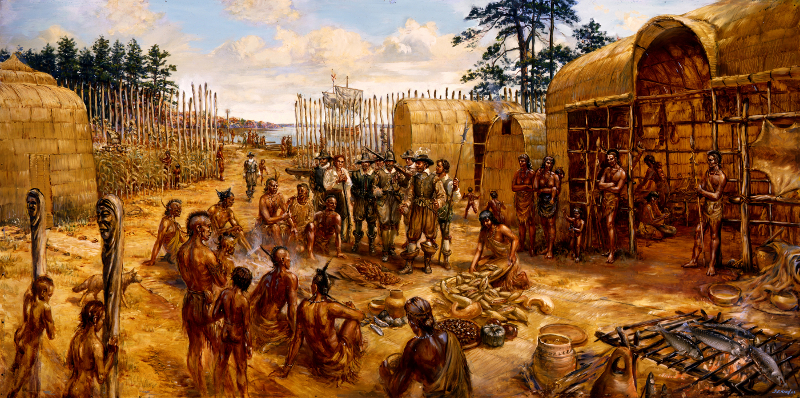
From the Washington Post, "Mystery of Va.'s First Slaves Is Unlocked 400 Years Later," by Lisa Rein, on 3 September 2006--JAMESTOWN -- They were known as the "20 and odd," the first African slaves to set foot in North America at the English colony settled in 1607.
For nearly 400 years, historians believed they were transported to Virginia from the West Indies on a Dutch warship. Little else was known of the Africans, who left no trace.

Now, new scholarship and transatlantic detective work have solved the puzzle of who they were and where their forced journey across the Atlantic Ocean began.
The slaves were herded onto a Portuguese slave ship in Angola, in Southwest Africa. The ship was seized by British pirates on the high seas -- not brought to Virginia after a period of time in the Caribbean. The slaves represented one ethnic group, not many, as historians first believed.

The discovery has tapped a rich vein of history that will go on public view next month at the Jamestown Settlement. The museum and living history program will commemorate the 400th anniversary of Jamestown's founding by revamping the exhibits and artifacts -- as well as the story of the settlement itself.
Although historians have thoroughly documented the direct slave trade from Africa starting in the 1700s, far less was known of the first blacks who arrived in Virginia and other colonies a century earlier. A story of memory and cultural connections between Africa and the early New World is being unearthed in a state whose plantation economy set the course for the Civil War.

"We went entirely back to the drawing board," said Tom Davidson, senior curator of the Jamestown-Yorktown Foundation. "The problem has always been that all of the things that make for a human story [of the Africans] were missing. . . . Now we can talk about the Africans with the same richness we talk about the English and the Powhatans."
Behind him, an Angolan man was depicted stripping bark from a baobab tree in a re-created village featured in the museum's new 30,000-square-foot gallery, which will open Oct. 16. It's double the space of the previous one, to cover a long span of the 17th century and the African story, which was barely featured before.

How the story of the charter generation of Africans in Virginia has come to life in a new $25 million museum wing is a tale of two scholars who helped connect two coasts of the Atlantic Ocean.
The early 1600s was a time of war and empire-building in Southwest Africa; Portuguese traders under the rule of the king of Spain had established the colony of Angola. The exporting of slaves to the Spanish New World was a profitable enterprise. The Portuguese waged war against the kingdoms of Ndongo and Kongo to the north, capturing and deporting thousands of men and women. They passed through a slave fortress at the port city of Luanda, still Angola's capital.
At Jamestown, tobacco was on the verge of a boom after the British had failed at several industries. Indentured servants from England were common in the settlement, now close to 1,000 people strong.

John Rolfe, Virginia's first tobacco planter and husband of the Indian princess Pocahontas, wrote the widely held account of the African landing in a letter to the Virginia Company of London. The captain of a Dutch warship that arrived in Jamestown in August 1619 "brought not any thing but 20 and odd Negroes, wch the Governor and Cape Marchant bought for victuale . . . at the best and easyest rate they could." Rolfe explained that the ship and another called the Treasurer had embarked from the West Indies.
A retired University of California at Berkeley historian, Engel Sluiter, made a startling discovery in the Spanish national archives in the late 1990s as he did research for a book on Spanish America. A colonial shipping document he uncovered in an account book identified a Portuguese slave ship called the San Juan Bautista. About 350 slaves were bound for Veracruz, on the east coast of modern-day Mexico, when the ship was robbed of its human cargo off the coast of Mexico in 1619 by two unidentified pirate ships, the record said.

Sluiter, who died in 2001, published his discovery in the William and Mary Quarterly. It caught the eye of John Thornton, an expert on the Portuguese colonies in Africa in the 16th and 17th centuries.
The outlines of the other half of the story took shape.
"I said, 'I can figure out how these people were enslaved,' " said Thornton, a Boston University professor who, with his wife, historian Linda Heywood, is publishing a book on the slave trade between Angola and the North American colonies. Previous scholarship has documented the slave trade from Ghana, Senegal and other parts of West Africa. "We know Angola was a big exporter of slaves to Brazil and the Spanish colonies, but now we know that they showed up here," Thornton said.
Through records of a legal dispute between the pirate ships, Thornton identified the British vessels as the Treasurer and the White Lion, which was flying a Dutch flag. Each took 20 to 30 slaves before the San Juan Bautista continued to Veracruz. They landed at Jamestown within four days of each other and traded the Africans for provisions. The Treasurer then sailed to Bermuda, dropping off more slaves, and returned to Virginia a few months later, trading the final nine or 10 more.
Many Angolans followed -- not just to Virginia, but to New York and New England, say Thornton and Heywood, who are consultants to the Jamestown Settlement. Their research draws a portrait of the first Africans as urban people connected by common languages, who had had contact with Europeans for many years.
Virginia's first Africans spoke Bantu languages called Kimbundu and Kikongo. Their homelands were the kingdoms of Ndongo and Kongo, regions of modern-day Angola and coastal regions of Congo. Both were conquered by the Portuguese in the 1500s. The Africans mined tar and rock salt, used shells as money and highly valued their children, holding initiation ceremonies to prepare them for adulthood.
And they most likely had been baptized as Christians, because the kingdom of Ndongo converted to Christianity in 1490. Many were literate. This background may be one reason some of Virginia's first Africans won their freedom after years as indentured servants, the historians said.

The Portuguese and Catholic roots figure prominently on a glass wall in the new gallery at the Jamestown Settlement. Mareo, Christian, Nando, Acquera, Palmena, Cuba, Salvo -- they are among 400 African names engraved on the wall, one for each anniversary year.
One is Angelo, whose name appears on a 1624 census of the colony discovered in the past decade. She is listed as a "Negro woman" who came on the Treasurer and worked as a servant in the home of Capt. William Pierce and his wife, June. Historians assume the slave's name was Angela.

It is Angela, played by a young Angolan actress, who stars in the introductory film visitors will see as they watch the new story of Jamestown unfold. The 23-minute movie was filmed on a beach in Luanda in 2004.
The film will replace a 15-year-old version that gives the first Africans only a passing mention. Now visitors will be transported to a Portuguese cathedral in Luanda, where a Jesuit priest breaks bread with the captains of the San Juan Bautista. They discuss the souls to be saved and riches to be made from the continued shipment of slaves from Massangano, an inland city. The film cuts to a hut on the shore of the Kwanza River, where Angela, a young woman in her twenties, pounds grain and smiles. Then she and thousands of others are captured and taken to a beach at Luanda. A Jesuit priest asks her if she has been baptized, and she answers yes.
"Then she is a child of God. When she dies, she will go to heaven," the priest says. And the slave ship sets sail against the evening sun. (source: The Washington Post)

Thanks for your good Post
ReplyDeletehttp://www.livestreamsportshd.com/
CULTURE IS WEAPON, CULTURE TEACHES OUR BEHAVIOR TO BE GOOD JOGJA CONCERNING INDONESIA https://mataramgolonggilig.wordpres.com
ReplyDeleteYOUTUBE: Metaphysics 2018, tadpole
November 14, 2018 GAMELAN KERAMAT is released from KRATON at 9:00 p.m.
November 7, 2018 the meeting of the WORLD MUSIC PENDEKAR in JOGJA, in DESA GILANGHARJO PANDAK BANTUL 10.00-24.00
November 20, 2018 GAMELAN KERAMAT is returned to the Kingdom at 9:00 p.m.
21 November 2018 MOUNTAIN MOUNTAINS 09.00-15.00 to THREE DIRECTIONS
JOGJA AWARE OF INDONESIA https://mataramgolonggilig.wordpres.com
YOUTUBE: Metaphysics 2018, tadpole
November 14, 2018 GAMELAN KERAMAT is released from KRATON at 9:00 p.m.
November 7, 2018 the meeting of the WORLD MUSIC PENDEKAR in JOGJA, in DESA GILANGHARJO PANDAK BANTUL 10.00-24.00
November 20, 2018 GAMELAN KERAMAT is returned to the Kingdom at 9:00 p.m.
21 November 2018 MOUNTAIN MOUNTAINS 09.00-15.00 to THREE DIRECTIONS
JOGJA SPIRITUAL CONCENTRATION CENTER in Pamantani sempor donokerto sleman would like to visit PAMANTANI - WA.085725835029 please visit PAMANTANI
Specially 1day along with JOGJA MEDITATION SPIRITUAL SPIRITUAL TOUR JAVA Rp.775.000 / person - Rp.4.750.000 / group 10 0rang, go to GUNUNGGAMBAR + Giriloyo + KOTAGEDE + Mangunan Contact @ r.kamajaya07 @reshy_geni #kotagede IMAGINATION JAVA LEGEND
grb45bse96
ReplyDeletegolden goose outlet
golden goose outlet
supreme outlet
golden goose outlet
golden goose outlet
golden goose outlet
golden goose outlet
golden goose outlet
golden goose outlet
golden goose outlet